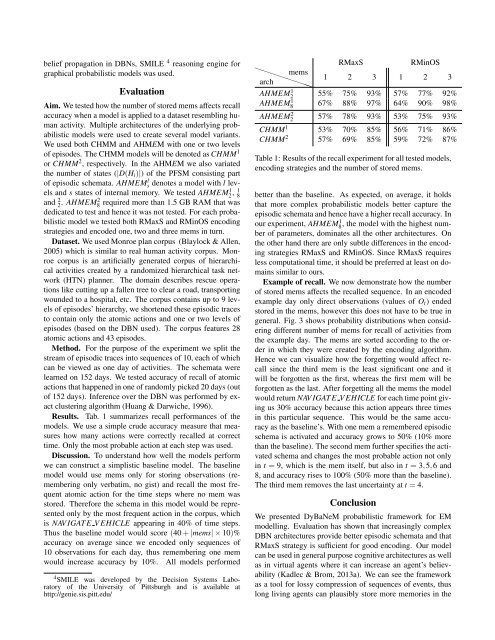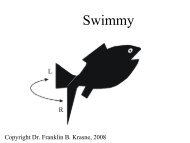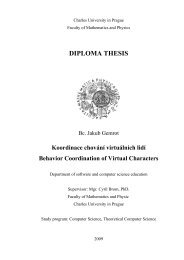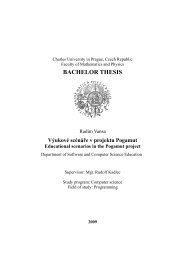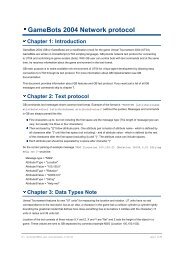DyBaNeM: Bayesian Framework for Episodic Memory Modelling
DyBaNeM: Bayesian Framework for Episodic Memory Modelling
DyBaNeM: Bayesian Framework for Episodic Memory Modelling
Create successful ePaper yourself
Turn your PDF publications into a flip-book with our unique Google optimized e-Paper software.
elief propagation in DBNs, SMILE 4 reasoning engine <strong>for</strong><br />
graphical probabilistic models was used.<br />
Evaluation<br />
Aim. We tested how the number of stored mems affects recall<br />
accuracy when a model is applied to a dataset resembling human<br />
activity. Multiple architectures of the underlying probabilistic<br />
models were used to create several model variants.<br />
We used both CHMM and AHMEM with one or two levels<br />
of episodes. The CHMM models will be denoted as CHMM 1<br />
or CHMM 2 , respectively. In the AHMEM we also variated<br />
the number of states (|D(H i )|) of the PFSM consisting part<br />
of episodic schemata. AHMEMs l denotes a model with l levels<br />
and s states of internal memory. We tested AHMEM2 1, 1 8<br />
and 2 2 . AHMEM2 8 required more than 1.5 GB RAM that was<br />
dedicated to test and hence it was not tested. For each probabilistic<br />
model we tested both RMaxS and RMinOS encoding<br />
strategies and encoded one, two and three mems in turn.<br />
Dataset. We used Monroe plan corpus (Blaylock & Allen,<br />
2005) which is similar to real human activity corpus. Monroe<br />
corpus is an artificially generated corpus of hierarchical<br />
activities created by a randomized hierarchical task network<br />
(HTN) planner. The domain describes rescue operations<br />
like cutting up a fallen tree to clear a road, transporting<br />
wounded to a hospital, etc. The corpus contains up to 9 levels<br />
of episodes’ hierarchy, we shortened these episodic traces<br />
to contain only the atomic actions and one or two levels of<br />
episodes (based on the DBN used). The corpus features 28<br />
atomic actions and 43 episodes.<br />
Method. For the purpose of the experiment we split the<br />
stream of episodic traces into sequences of 10, each of which<br />
can be viewed as one day of activities. The schemata were<br />
learned on 152 days. We tested accuracy of recall of atomic<br />
actions that happened in one of randomly picked 20 days (out<br />
of 152 days). Inference over the DBN was per<strong>for</strong>med by exact<br />
clustering algorithm (Huang & Darwiche, 1996).<br />
Results. Tab. 1 summarizes recall per<strong>for</strong>mances of the<br />
models. We use a simple crude accuracy measure that measures<br />
how many actions were correctly recalled at correct<br />
time. Only the most probable action at each step was used.<br />
Discussion. To understand how well the models per<strong>for</strong>m<br />
we can construct a simplistic baseline model. The baseline<br />
model would use mems only <strong>for</strong> storing observations (remembering<br />
only verbatim, no gist) and recall the most frequent<br />
atomic action <strong>for</strong> the time steps where no mem was<br />
stored. There<strong>for</strong>e the schema in this model would be represented<br />
only by the most frequent action in the corpus, which<br />
is NAV IGAT E V EHICLE appearing in 40% of time steps.<br />
Thus the baseline model would score (40 + |mems| × 10)%<br />
accuracy on average since we encoded only sequences of<br />
10 observations <strong>for</strong> each day, thus remembering one mem<br />
would increase accuracy by 10%. All models per<strong>for</strong>med<br />
4 SMILE was developed by the Decision Systems Laboratory<br />
of the University of Pittsburgh and is available at<br />
http://genie.sis.pitt.edu/<br />
RMaxS<br />
RMinOS<br />
mems<br />
1 2 3 1 2 3<br />
arch <br />
AHMEM2 1 55% 75% 93% 57% 77% 92%<br />
AHMEM8 1 67% 88% 97% 64% 90% 98%<br />
AHMEM 2 2 57% 78% 93% 53% 75% 93%<br />
CHMM 1 53% 70% 85% 56% 71% 86%<br />
CHMM 2 57% 69% 85% 59% 72% 87%<br />
Table 1: Results of the recall experiment <strong>for</strong> all tested models,<br />
encoding strategies and the number of stored mems.<br />
better than the baseline. As expected, on average, it holds<br />
that more complex probabilistic models better capture the<br />
episodic schemata and hence have a higher recall accuracy. In<br />
our experiment, AHMEM8 1 , the model with the highest number<br />
of parameters, dominates all the other architectures. On<br />
the other hand there are only subtle differences in the encoding<br />
strategies RMaxS and RMinOS. Since RMaxS requires<br />
less computational time, it should be preferred at least on domains<br />
similar to ours.<br />
Example of recall. We now demonstrate how the number<br />
of stored mems affects the recalled sequence. In an encoded<br />
example day only direct observations (values of O t ) ended<br />
stored in the mems, however this does not have to be true in<br />
general. Fig. 3 shows probability distributions when considering<br />
different number of mems <strong>for</strong> recall of activities from<br />
the example day. The mems are sorted according to the order<br />
in which they were created by the encoding algorithm.<br />
Hence we can visualize how the <strong>for</strong>getting would affect recall<br />
since the third mem is the least significant one and it<br />
will be <strong>for</strong>gotten as the first, whereas the first mem will be<br />
<strong>for</strong>gotten as the last. After <strong>for</strong>getting all the mems the model<br />
would return NAV IGAT E V EHICLE <strong>for</strong> each time point giving<br />
us 30% accuracy because this action appears three times<br />
in this particular sequence. This would be the same accuracy<br />
as the baseline’s. With one mem a remembered episodic<br />
schema is activated and accuracy grows to 50% (10% more<br />
than the baseline). The second mem further specifies the activated<br />
schema and changes the most probable action not only<br />
in t = 9, which is the mem itself, but also in t = 3,5,6 and<br />
8, and accuracy rises to 100% (50% more than the baseline).<br />
The third mem removes the last uncertainty at t = 4.<br />
Conclusion<br />
We presented <strong>DyBaNeM</strong> probabilistic framework <strong>for</strong> EM<br />
modelling. Evaluation has shown that increasingly complex<br />
DBN architectures provide better episodic schemata and that<br />
RMaxS strategy is sufficient <strong>for</strong> good encoding. Our model<br />
can be used in general purpose cognitive architectures as well<br />
as in virtual agents where it can increase an agent’s believability<br />
(Kadlec & Brom, 2013a). We can see the framework<br />
as a tool <strong>for</strong> lossy compression of sequences of events, thus<br />
long living agents can plausibly store more memories in the


